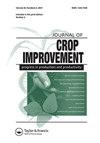Maternal environment and genetic mechanisms that regulate primary dormancy and the rate of dormancy loss in barley seeds
IF 1.5
Q3 AGRONOMY
引用次数: 1
Abstract
ABSTRACT Pre-harvest sprouting is a concern in malting barley (Hordeum vulgare L.) in areas with a high amount of rainfall, as it decreases grain yield and malt quality. Thus, we investigated the changes in initial germination and the rate of dormancy loss in seeds of 20 promising barley genotypes at seven locations for two years (2013–2015) in Iran. Initial germination ranged between 5.23% (genotype “Teran 78/1-BC-80,411”) and 38.45% (genotype “CIRU/M111”) at the maturity. In several genotypes, there were negative associations between initial germination and the average temperature in March, April and May. The rate of dormancy loss and precipitation were negatively correlated in 14 genotypes in March. Thus, a hot and dry condition during seed development can decrease initial germination but can increase the rate of dormancy loss in barley. A genotype with high initial germination is suitable for cultivation in regions with a dry climate during grain development, and a genotype with a high rate of dormancy loss is appropriate in a climate with high rainfall and relative humidity. In conclusion, breeding programs must link dormancy intensity of target barley and environmental conditions (air temperature and humidity) that the crop will experience.调节大麦种子初级休眠和休眠损失率的母体环境和遗传机制
摘要:在降雨量大的地区,大麦(Hordeum vulgare L.)在收获前发芽是一个令人担忧的问题,因为它会降低谷物产量和麦芽质量。因此,我们研究了伊朗7个地点(2013-2015年)20种有前景的大麦基因型种子的初始发芽率和休眠损失率的变化。成熟时的初始发芽率在5.23%(基因型“Teran 78/1-BC-80411”)和38.45%(基因型”CIRU/M111“)之间。在几个基因型中,初芽与3、4、5月的平均气温呈负相关,其中14个基因型的3月休眠损失率与降水量呈负相关。因此,大麦种子发育过程中的高温和干燥条件会降低初始发芽率,但会增加休眠损失率。初始发芽率高的基因型适合在粮食发育过程中气候干燥的地区种植,休眠损失率高的品种适合在降雨量和相对湿度高的气候中种植。总之,育种计划必须将目标大麦的休眠强度与作物将经历的环境条件(空气温度和湿度)联系起来。
本文章由计算机程序翻译,如有差异,请以英文原文为准。
求助全文
约1分钟内获得全文
求助全文
来源期刊

Journal of Crop Improvement
Multiple-
CiteScore
3.30
自引率
7.70%
发文量
42
期刊介绍:
Journal of Crop Science and Biotechnology (JCSB) is a peer-reviewed international journal published four times a year. JCSB publishes novel and advanced original research articles on topics related to the production science of field crops and resource plants, including cropping systems, sustainable agriculture, environmental change, post-harvest management, biodiversity, crop improvement, and recent advances in physiology and molecular biology. Also covered are related subjects in a wide range of sciences such as the ecological and physiological aspects of crop production and genetic, breeding, and biotechnological approaches for crop improvement.
 求助内容:
求助内容: 应助结果提醒方式:
应助结果提醒方式:


